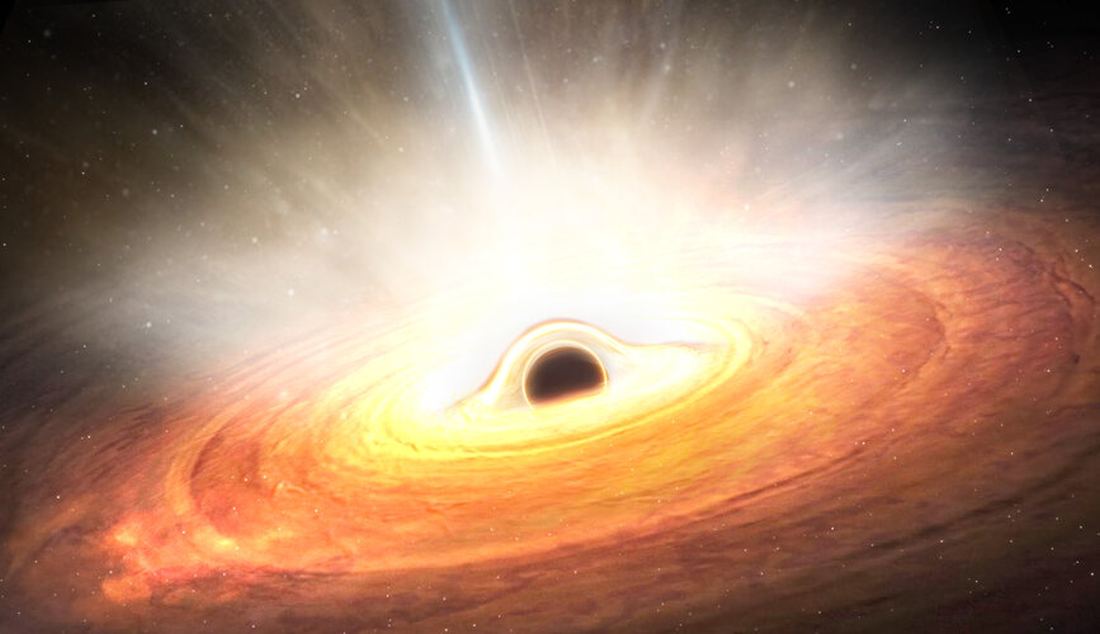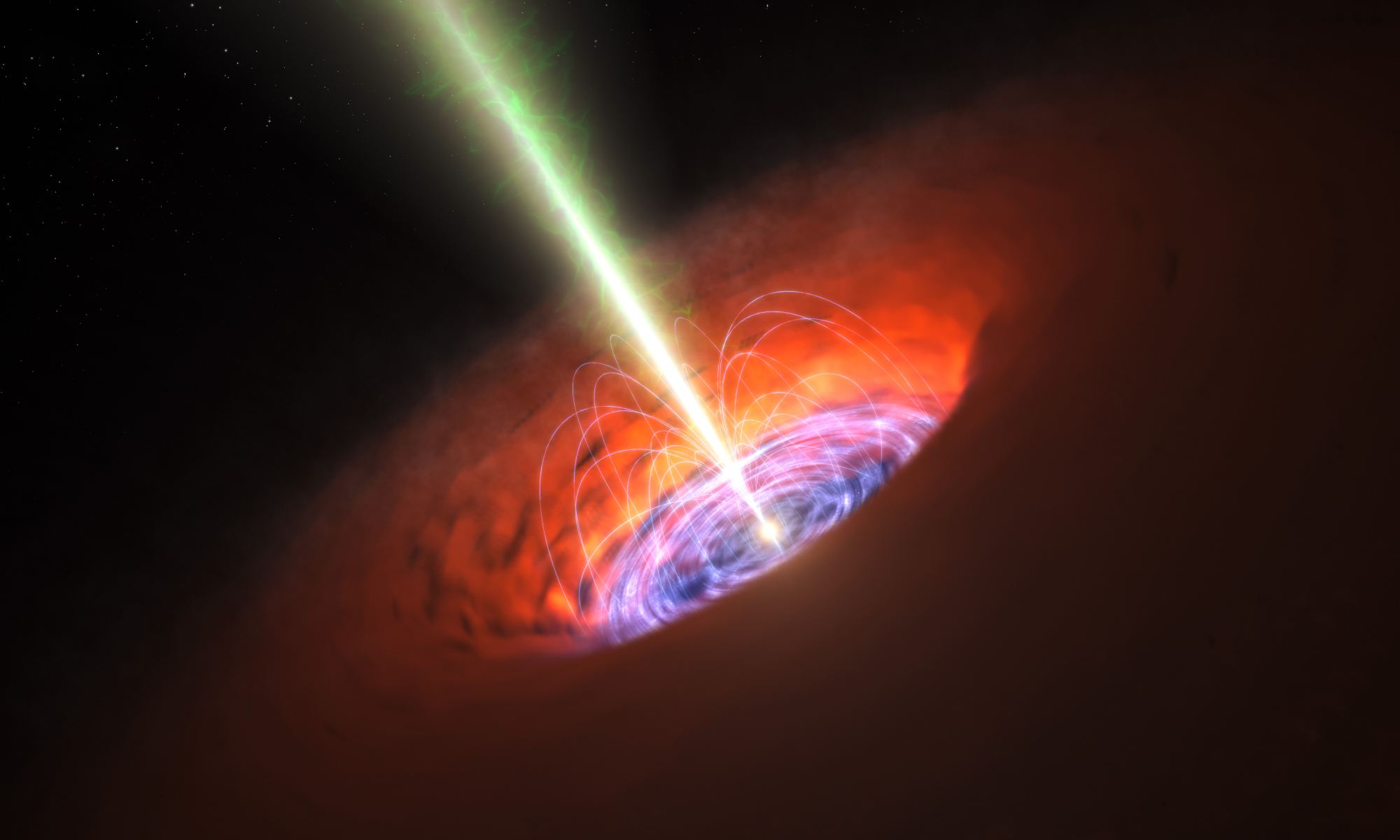The long-awaited detection of gravitational waves has opened up a whole new world of astronomy. One of the key efforts is now to tie signals across multiple domains – for example, a gravitational wave and the associated electromagnetic radiation created by that same event, such as a black hole merger or a gamma-ray burst. We’ll need new equipment to detect such “multimodal” signals, especially electromagnetic ones. One such project is the Black Hole Coded Aperture Telescope (BlackCAT), which will be launched early this year by a team led by researchers at Penn State.
Continue reading “A CubeSat Mission Will Detect X-rays from GRBs and Black-Hole Mergers”New Research may Explain how Supermassive Black Holes in the Early Universe Grew so Fast

Not long ago, the James Webb Space Telescope (JWST) peered into Cosmic Dawn, the cosmological period when the first galaxies formed less than one billion years after the Big Bang. In the process, it discovered something rather surprising. Not only were there more galaxies (and brighter ones, too!) than expected, but these galaxies had supermassive black holes (SMBH) much larger than cosmological models predicted. For astronomers and cosmologists, explaining how these galaxies and their SMBHs (aka. quasars) could have grown so large less than a billion years after the Big Bang has become a major challenge.
Several proposals have been made, ranging from optical illusions to Dark Matter accelerating black hole growth. In a recent study, an international team led by researchers from the National Institute for Astrophysics (INAF) analyzed a sample of 21 quasars, among the most distant ever discovered. The results suggest that the supermassive black holes at the center of these galaxies may have reached their surprising masses through very rapid accretion, providing a plausible explanation for how galaxies and their SMBHs grew and evolved during the early Universe.
Continue reading “New Research may Explain how Supermassive Black Holes in the Early Universe Grew so Fast”eROSITA All-Sky Survey Takes the Local Hot Bubble’s Temperature

About half a century ago, astronomers theorized that the Solar System is situated in a low-density hot gas environment. This hot gas emits soft X-rays that displace the dust in the local interstellar medium (ISM), creating what is known as the Local Hot Bubble (LHB). This theory arose to explain the ubiquitous soft X-ray background (below 0.2 keV) and the lack of dust in our cosmic neighborhood. This theory has faced some challenges over the years, including the discovery that solar wind and neutral atoms interact with the heliosphere, leading to similar emissions of soft X-rays.
Thanks to new research by an international team of scientists led by the Max Planck Institute for Extraterrestrial Physics (MPE), we now have a 3D model of the hot gas in the Solar System’s neighborhood. Using data obtained by the eROSITA All-Sky Survey (eRASS1), they detected large-scale temperature differences in the LHBT that indicate that the LHB must exist, and both it and solar wind interaction contribute to the soft X-ray background. They also revealed an interstellar tunnel that could possibly link the LHB to a larger “superbubble.”
Continue reading “eROSITA All-Sky Survey Takes the Local Hot Bubble’s Temperature”These Three Neutron Stars Shouldn't Be So Cold

Neutron stars are among the densest objects in the Universe, second only to black holes. Like black holes, neutron stars are what remains after a star reaches the end of its life cycle and undergoes gravitational collapse. This produces a massive explosion (a supernova), in which a star sheds its outer layers and leaves behind a super-compressed stellar remnant. In fact, scientists speculate that matter at the center of the star is compressed to the point that even atoms collapse and electrons merge with protons to create neutrons.
Traditionally, scientists have relied on the “Equation of State” – a theoretical model that describes the state of matter under a given set of physical conditions – to understand what physical processes can occur inside a neutron star. But when a team led by scientists from the Spanish National Research Council (CSIC) examined three exceptionally young neutron stars, they noticed they were 10-100 times colder than other neutron stars of the same age. For this, the researchers concluded that these three stars are inconsistent with most of the proposed equations of state.
Continue reading “These Three Neutron Stars Shouldn't Be So Cold”Which Stars are Lethal to their Planets?
Many years ago, there was a viral YouTube video called “History of the entire world, i guess,” which has been an endless source of internet memes since its release. One of the most prominent is also scientifically accurate—when describing why animals couldn’t start living on land, the video’s creator, Bill Wurtz, intones, “The Sun is a deadly laser.”
Continue reading “Which Stars are Lethal to their Planets?”New Simulation Explains how Supermassive Black Holes Grew so Quickly

One of the main scientific objectives of next-generation observatories (like the James Webb Space Telescope) has been to observe the first galaxies in the Universe – those that existed at Cosmic Dawn. This period is when the first stars, galaxies, and black holes in our Universe formed, roughly 50 million to 1 billion years after the Big Bang. By examining how these galaxies formed and evolved during the earliest cosmological periods, astronomers will have a complete picture of how the Universe has changed with time.
As addressed in previous articles, the results of Webb‘s most distant observations have turned up a few surprises. In addition to revealing that galaxies formed rapidly in the early Universe, astronomers also noticed these galaxies had particularly massive supermassive black holes (SMBH) at their centers. This was particularly confounding since, according to conventional models, these galaxies and black holes didn’t have enough time to form. In a recent study, a team led by Penn State astronomers has developed a model that could explain how SMBHs grew so quickly in the early Universe.
Continue reading “New Simulation Explains how Supermassive Black Holes Grew so Quickly”Stellar Winds Coming From Other Stars Measured for the First Time

An international research team led by the University of Vienna has made a major breakthrough. In a study recently published in Nature Astronomy, they describe how they conducted the first direct measurements of stellar wind in three Sun-like star systems. Using X-ray emission data obtained by the ESA’s X-ray Multi-Mirror-Newton (XMM-Newton) of these stars’ “astrospheres,” they measured the mass loss rate of these stars via stellar winds. The study of how stars and planets co-evolve could assist in the search for life while also helping astronomers predict the future evolution of our Solar System.
Continue reading “Stellar Winds Coming From Other Stars Measured for the First Time”Brightest Gamma-ray Burst Shines Light on Milky Way Structure
The brightest gamma-ray burst ever seen in 2022 still puzzles astronomers.
The more researchers look at a recent record-setting event, the stranger it gets.
The story begins on the evening of October 9th, 2022, when NASA’s Neil Gehrels Swift orbiting observatory detected a strong X-ray outburst. The source was in the direction of the constellation of Sagitta the Arrow along the galactic plane, suggesting a source in our own Milky Way galaxy. Follow-up observations from NASA’s Fermi Gamma-Ray Space Telescope and the Earth-based European Southern Observatory’s Very Large Telescope however, soon revealed that the source was much more distant, emanating from a gamma-ray burst lying beyond our galaxy. This outburst only appeared to have happened along our line of sight as seen through the plane own galaxy from our Earthbound perspective.
Continue reading “Brightest Gamma-ray Burst Shines Light on Milky Way Structure”A Distant Galaxy Ate All of its Friends. Now It’s All Alone

Over 13 billion years ago, the first galaxies in the Universe formed. They were elliptical, with intermediate black holes (IMBHs) at their centers surrounded by a halo of stars, gas, and dust. Over time, these galaxies evolved by flattening out into disks with a large bulge in the middle. They were then drawn together by mutual gravitational attraction to form galaxy clusters, massive collections that comprise the large-scale cosmic structure. This force of attraction also led to mergers, where galaxies and their central black holes came together to create larger spiral galaxies with central supermassive black holes (SMBHs).
This process of mergers and assimilation (and their role in galactic evolution) is still a mystery to astronomers today since much of it took place during the early Universe, which is still very difficult to observe with existing telescopes. Using data from NASA’s Chandra X-ray Observatory and the International Gemini Observatory, an international team of astronomers observed a lone distant galaxy that appears to have consumed all of its former companions. Their findings, which recently appeared in The Astrophysical Journal, suggest galaxies in the early Universe grew faster than previously thought.
Continue reading “A Distant Galaxy Ate All of its Friends. Now It’s All Alone”Hungry Black Hole was Already Feasting 800 Million Years After the Big Bang
Black holes swallow everything—including light—which explains why we can’t see them. But we can observe their immediate surroundings and learn about them. And when they’re on a feeding binge, their surroundings become even more luminous and observable.
This increased luminosity allowed astronomers to find a black hole that was feasting on material only 800 million years after the Universe began.
Continue reading “Hungry Black Hole was Already Feasting 800 Million Years After the Big Bang”



